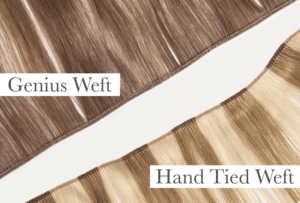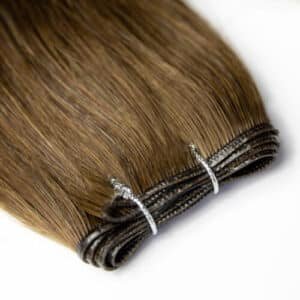In an era where personal grooming and beauty customization are paramount, hair extensions have emerged as a transformative solution for countless individuals. But with the rise in demand for these luscious locks, the inevitable question emerges: Is it essential to be licensed to craft these hair wonders? Dive in to unravel the tapestry of qualifications, licensing, and the world of hair extensions.
Certainly. While installing hair extensions may seem straightforward, the intricate process requires both precision and expertise. In this industry, two main pillars define professional competence: licensing and certification. Licensing, mandated by authorities, validates a professional’s right to operate, ensuring basic competency. Certification, however, is more specialized, reflecting a professional’s dedication to mastering certain techniques or products.
For a comprehensive understanding of hair extension licensing and certification, and why they’re crucial, keep reading.
1

1
Potential Consequences of Untrained Installation
1
Navigating the realm of hair extensions without proper training can not only lead to aesthetic blunders but may also have more severe implications for an individual’s scalp and overall hair health. Let’s explore some of the critical concerns further:
Hair Damage:
Strain and Breakage: Incorrect installation can tug at the roots, creating undue stress, which can lead to hair breakage.
Uneven Weight Distribution: Extensions that aren’t correctly applied can distribute weight unevenly, leading to patches of hair loss.
Chemical Damage: Some extensions require bonding solutions, which, if not used correctly, can compromise hair integrity.
Scalp Health:
Irritations: Improper cleaning and preparation can lead to irritations on the scalp, causing discomfort and redness.
Infections: Using non-sterilized tools or neglecting hygiene during the process might pave the way for bacterial or fungal infections.
Traction Alopecia: Continuous strain on hair follicles due to poorly installed extensions can lead to a condition called traction alopecia, a form of gradual hair loss.
Aesthetic Concerns:
Unnatural Appearance: Extensions should blend seamlessly. Without the right training, there’s a risk of mismatched hair textures or colors, creating a stark contrast between the extensions and natural hair.
Uneven Lengths:
Properly trained professionals know how to achieve a gradient and natural flow. Inexperienced hands might leave extensions looking choppy or uneven.
Visible Bonds or Tapes:
The bonding areas of extensions, whether they are tapes, glues, or weaves, should be concealed. Untrained installation can leave these bonds exposed, detracting from the overall appearance.
Embarking on the journey of hair extensions, whether as a provider or a receiver, necessitates an understanding of these potential pitfalls. Proper training can significantly mitigate these risks, ensuring a safer and more aesthetically pleasing result.
1

1
What are hair Licensing & hair extensions Certifications?
1
In the multifaceted world of hair extensions, both licensing and certifications play pivotal roles. They ensure professionalism, quality, and trustworthiness for clients seeking the perfect hair transformation. While they both serve to validate a professional’s skill and expertise, they have distinct characteristics and purposes. Let’s break down each and highlight their differences.
Licensing in Hair Extensions:
Foundation of Trust and Legitimacy: Licensing serves as a beacon of credibility. It establishes a professional’s right to operate within certain geographical boundaries, typically granted by either a regional governmental entity or an industry-specific hairdressing association. Holding a valid industry license assures clients and regulators alike of the practitioner’s legitimacy.
Defining its Scope: In the realm of hair extensions, a license acts as a testament to a professional’s commitment to maintaining the utmost safety and quality standards. It’s an affirmation that professionals have met the stringent standards set by regulatory bodies, ensuring they possess the knowledge and expertise to provide safe and high-quality services.
Certifications in Hair Extensions:
Certifications are badges of specialized expertise. They are formal recognitions awarded to individuals who have undergone and completed specialized training in specific techniques or skills. Within the hair extension industry, certifications can encompass a broad spectrum, from general techniques to niche methods like “Keratin Bond Extensions” or “Tape-In Extensions.” Acquiring a certification assures clients that the stylist has received dedicated training in the particular method they’re seeking, elevating their level of expertise and precision.
Distinguishing Licensing from Certifications:
While both licensing and certifications underscore a professional’s competence, they cater to different aspects of validation:
Nature: Licensing is often a mandatory requirement to legally operate in a region or country, whereas certifications are typically voluntary, representing specialized training in specific techniques or products.
Issuance: Licensing is usually issued by government entities or recognized industry associations. In contrast, certifications are often granted by educational institutions or specific product manufacturers after completing specialized courses.
Purpose: A license guarantees that the professional meets the general industry standards for operating safely and effectively. Certifications, on the other hand, highlight a stylist’s advanced expertise in specific areas, allowing them to cater to niche market demands.
In essence, while a license ensures a broad foundational knowledge and the legal right to operate, certifications delve deeper, spotlighting specialized skills and techniques that set professionals apart in a bustling market.
1

1
The Advantages and Path to Hair Extension Licensing
1
Licensing is not just a validation of skill but a testament to a professional’s commitment to excellence. Delve deeper to uncover the significance of being licensed in this dynamic domain and how it shapes the global hair extension narrative.
The Perks of Being Licensed:
Upholding Service Excellence: Being licensed is synonymous with quality. Clients are assured of premium services, making the difference between a fleeting visit and a dedicated, repeat customer. The license symbolizes more than just a service – it’s a commitment to offering a memorable experience.
Elevating Professional Stature: Trust and skill are the dual pillars of the beauty industry. A license doesn’t merely validate a professional’s ability but also catapults their reputation in the industry. With a license, professionals can anticipate an expanded clientele, accelerated career growth, and opportunities that range from partnerships to mentorship roles.
Promoting Industry Standardization: Obtaining a license ensures that professionals adhere to recognized standards, benchmarks, and best practices. This not only elevates the quality of services offered but also fosters a more organized, regulated, and cohesive industry. It drives professionals to maintain consistent standards, making the industry more reliable and trustworthy for consumers.
Navigating the Licensing Landscape Globally:
USA: Licensing intricacies are predominantly governed by individual states. The State Board of Cosmetology stands as the primary authority. While a cosmetology or hairstyling license remains a staple, certain states might necessitate more specialized hair extension credentials.
UK: The foundational requirement is often the Level 2 Diploma in Hairdressing. Complementing this with an NVQ can be advantageous, and associations with prestigious organizations, such as HABIA, can provide an extra edge.
Australia: For many, the journey begins with a Certificate III in Hairdressing. Yet, some regions may impose additional qualification prerequisites.
Canada: Hair extension procedures are typically categorized under hairstyling. Given the diversity in provincial regulations, it’s imperative to consult respective provincial regulatory boards.
South Africa: The Services SETA plays a pivotal role in setting standards. A National Diploma in Hairdressing or its equivalent is commonly the initiation point. However, for those aiming to differentiate themselves, delving into specialized hair extension courses can be worthwhile.
Regulatory Updates: It’s crucial to regularly consult with local and national regulatory boards, wherever you’re operating. Licensing criteria and training requirements are susceptible to changes, and staying updated ensures that you remain compliant, credible, and competitive in the market.
The Road Ahead:
The realm of hair extensions is an intricate blend of creativity, precision, and trust. Licensing becomes the cornerstone, balancing this delicate ecosystem. For professionals, it’s a journey that transcends beyond mastering techniques; it’s about etching a mark of trust, authenticity, and unmatched expertise in the industry’s tapestry.
1
The Advantages of Hair Extension Certifications and the Path to Obtain
1
Certifications provide this platform for professionals, offering a badge of verified expertise. This not only boosts a professional’s credibility but also empowers them to stand out in a saturated market. Let’s delve into the manifold benefits of obtaining certifications and the roadmap to achieving them.
Why Get Certified?
Credibility and Trust: Clients are more inclined to trust professionals who possess verified certifications. Such certifications reassure clients of the quality and standard of service they can expect.
Professional Development and Skill Enhancement: Obtaining a certification is not just about validation but also about growth. Engaging with a structured course helps professionals refine their techniques, learn new methods, and elevate their craft to a higher level.
Staying Current: The beauty industry, especially the niche of hair extensions, witnesses rapid advancements. Certifications often require periodic renewals, pushing professionals to stay abreast of the latest techniques and trends.
Competitive Edge: In a market where everyone claims expertise, certifications offer tangible proof of a professional’s skills, giving them a distinct advantage over competitors.
Networking Opportunities: Being a certified professional can open doors to exclusive industry events, allowing one to network with other experts and potentially collaborate on projects.
Increased Earnings: Often, certified professionals can command higher prices for their services, given the perceived value and assurance of quality.
1

1
Embarking on the Certification Journey: Key Institutions and Platforms
Bellami Hair: Besides being a market leader in hair extensions, Bellami offers specialized training in a plethora of extension techniques.
Great Lengths: This global brand offers accredited courses, introducing professionals to state-of-the-art products and pioneering methods.
Toni & Guy Hairdressing Academy: This institution harmoniously integrates age-old techniques with contemporary trends, imparting holistic training.
Hairdreams: With a focus on elite training modules, this institution is steered by some of the brightest minds in the industry.
Hotheads: Recognized for their prowess in tape-in extensions, their training underscores perfecting the application of their signature product.
Donna Bella Hair: Their extensive training curriculum covers a wide spectrum, from the nuances of installation to the intricacies of maintenance.
For those inclined towards online learning, platforms such as Udemy, Coursera, Skillshare, and MasterClass host myriad courses on diverse hair extension methodologies, all under the tutelage of industry veterans.
1

1
Charting the Right Certification Course:
Alignment with Services: Ensure the chosen certification is in tandem with the services you offer.
Pulse of the Local Market: Grasp the preferences of your local clientele, ascertaining which certification resonates the most.
Commitment to Progress: Prioritize institutions that are forward-thinking, constantly updating their curriculum as per industry shifts.
Valuable Collaborations: Some certifications pave the way for partnerships, granting access to industry-leading tools or events.
Peers’ Testimonials: Before making a choice, consult fellow professionals. Their firsthand experiences can be a guiding light.
In the bustling world of hair extensions, a certification is more than just a piece of paper. It’s an affirmation of a professional’s dedication to their craft. As techniques evolve and new trends emerge, ensuring you’re certified from a recognized institution can be the linchpin for both professional growth and client satisfaction.
1
Hair Extension Varieties and certification Nuances
1
Here’s a comprehensive look at some prevalent extension techniques, along with a few specific products in each category, and the associated regulatory nuances:
1、Quick-Install Extensions:
Nature of Extensions: Quick-install extensions are designed for effortless application, perfect for individuals seeking a temporary change without the commitment of more permanent solutions. These extensions are generally detachable, allowing users to clip or place them onto their natural hair with ease.
Overview: For personal and individual use, these extensions typically don’t require a license. However, professionals aiming to offer styling and custom fitting services for these products might need certification or training to ensure a natural look and safe application.
Popularity Reason: The primary appeal of quick-install extensions is their convenience. Users can instantly elevate their hair game for special occasions or daily wear and return to their natural style as desired. The non-committal nature of these extensions makes them a favorite among many.
Training Emphasis: While the installation is straightforward, training primarily concentrates on achieving a seamless blend with the natural hair and ensuring secure placement to avoid accidental detachments.
Highlight Products:
Clip-In Hair, Ponytail, Halo Hair, Bangs, etc.
1

1
2. Tape-In Extensions:
Nature of Extensions: Tape-in extensions involve wefts of hair attached to clear, double-sided tape. These wefts are then adhered to small sections of natural hair, lying flat against the head, which makes them less detectable than other extension types.
Overview: It’s crucial to approach tape-in extensions with a professional touch. Their adhesive nature means that incorrect application or removal can lead to hair damage or breakage. Therefore, obtaining training or certification is often advised for those looking to provide this service, to ensure optimal results and client safety.
Popularity Reason: Tape-ins provide a balance between temporary and permanent extensions. They last several weeks and can be reused, making them a cost-effective solution for those seeking longer, fuller hair without daily application. Additionally, the removal process is relatively simple, with specialized solutions available to break down the adhesive.
Training Emphasis: Given the adhesive nature of these extensions, training primarily focuses on the intricacies of application to avoid uneven placements, ensuring that the natural hair remains damage-free, and mastering the removal process to prevent breakage. Proper hands-on training equips professionals with techniques to seamlessly blend the extensions with natural hair, ensuring longevity and a natural look. Continuous education on updated products and adhesives is also emphasized to keep professionals at the forefront of the tape-in extension industry.
Highlight Products:
Regular Tape-Ins, Invisible Tape-Ins, Butterfly Tape-Ins, etc.
1

1
3. Keratin Bond Extensions:
Nature of Extensions: Keratin bond extensions, often known as “fusion” extensions, involve attaching individual strands of extension hair to one’s natural hair using keratin-based adhesive. The hot fusion keratin hair extension, bonding point is then heated, melting the keratin to fuse the extension to the natural hair. cold fusion keratin typically uses microbeads.
Overview: The intricacies of applying keratin bonds, paired with the potential for hair damage if not done correctly, make it essential for stylists to have a valid license. This ensures they’re familiar with the application, maintenance, and removal techniques to minimize risks and provide optimal results.
Popularity Reason: When applied correctly and maintained well, keratin bond extensions can last several months, making them one of the most long-lasting extension methods available. Their individualized placement allows for a very natural movement and blending with natural hair.
Training Emphasis: A comprehensive training program for keratin bond extensions should cover the science of hair and bonding materials, precise application techniques to ensure the bonds are undetectable and comfortable, maintenance and aftercare advice, and safe removal methods to minimize hair breakage or damage.
Highlight Products : U-tip, V-tip, Flat-tip, I-tip, Nano Ring, Micro Ring, etc.
1

1
4. Weave Extensions:
Nature of Extensions: Weave, or sew-in extensions, involve braiding the natural hair into cornrows and then sewing strips of weft hair onto these braids. It’s a technique that provides added length and volume to the hair.
Overview: The technique of sewing hair wefts into braided patterns requires a combination of precision and care. An incorrectly installed weave can lead to tension hair loss, known as traction alopecia. This makes specialized training and certification paramount for ensuring the health and safety of the client’s natural hair and scalp.
Popularity Reason: Weaves are particularly popular among those with thicker, coarser hair textures as they offer a protective style that can last for several weeks to months. They’re also favored for their versatility, allowing wearers to switch up their look without exposing their natural hair to potential damage from heat or styling products.
Training Emphasis: Professionals must understand various braiding techniques, tension management, and how to care for the scalp beneath the weave. They should also be skilled in customizing and cutting wefts to fit individual client needs, ensuring a seamless and natural appearance.
Highlight Products :
Machine Wefts, Volume wefts, Hand-tied Wefts, Flat Wefts, Genius wefts, etc.
As the panorama of hair extensions continues to diversify, staying updated on licensing and best practices is crucial. The aim? Ensuring that both professionals and clients have a positive, safe experience while achieving the hair of their dreams.
1

1
Conclusion:
1
In the dynamic realm of beauty, hair extensions are more than mere adornments—they represent a blend of technique, care, and personal expression. As the industry expands, the importance of qualifications cannot be overstated. It’s more than just a stamp of approval; it’s a commitment to excellence, ensuring that clients receive the best care and professionals uphold the highest standards. For every stylist and technician, venturing into this space with the right qualifications means not only securing a foothold but also elevating the entire industry one strand at a time.





